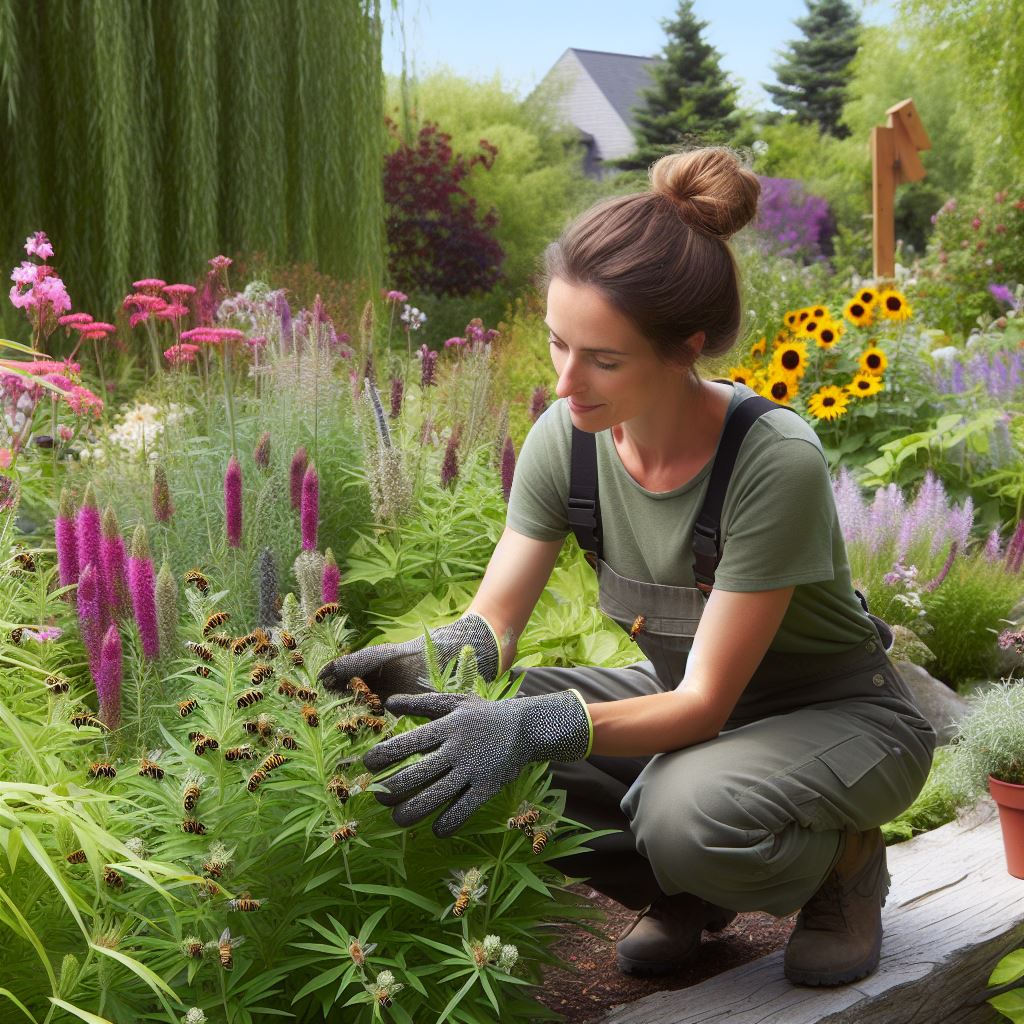Introduction
A pollinator garden is crucial as it provides habitats for important insects like bees and butterflies.
Creating a pollinator garden in Canada has several benefits, such as helping to preserve native plant species and ensuring a healthy ecosystem.
Pollinator gardens play a vital role in supporting dwindling populations of bees and other pollinators.
These insects are necessary for the pollination of flowers, fruits, and vegetables, promoting ecological balance.
Overview of the benefits of creating a pollinator garden in Canada
Not only do pollinator gardens enhance biodiversity, but they also contribute to the overall aesthetics of the landscape.
These gardens are filled with vibrant flowers and attract colorful butterflies and hummingbirds, adding beauty to any outdoor space.
Creating a pollinator garden in Canada also helps in the preservation of native plant species.
Many native plants are adapted to local ecosystems and serve as an important food source for pollinators, ensuring their survival.
By providing a home for pollinators, these gardens also aid in the reproduction of plants.
When pollinators visit flowers, they help in transferring pollen between plants, encouraging the growth of seeds and fruits.
Moreover, pollinator gardens in Canada offer an opportunity for educational outreach and citizen involvement.
They serve as a demonstration of sustainable gardening practices and inspire individuals to create their own pollinator-friendly habitats.
Basically, pollinator gardens are crucial ecological spaces that support biodiversity, preserve native plants, and enhance the beauty of landscapes.
Creating a pollinator garden in Canada is a small but significant step towards ensuring a healthy and sustainable ecosystem for future generations.
Understanding Pollinators in Canada
Pollinators and their role in ecosystems
- Pollinators are animals that help transfer pollen from the male to the female parts of plants.
- Their role is crucial for the reproduction of flowering plants and the production of fruits and seeds.
- By carrying pollen, pollinators facilitate fertilization and genetic diversity among plant populations.
- Pollinators play a significant role in supporting ecosystems, biodiversity, and food production.
Identification of common pollinators in Canada
- Bees: Many species of both native and honey bees are important pollinators in Canada.
- Butterflies: Various butterfly species, like the monarch butterfly, contribute to pollination.
- Moths: Moths are nocturnal pollinators that can be found across different regions in Canada.
- Hummingbirds: These small birds have long beaks, which enable them to reach nectar in flowers.
- Bats: Certain bat species play a vital role in pollinating night-blooming plants.
- Flies: Although often overlooked, flies also contribute as pollinators in certain plant species.
Description of the challenges faced by pollinators in Canada
- Habitat Loss: Urbanization and deforestation reduce the availability of suitable habitats for pollinators.
- Pesticide Use: The extensive use of pesticides can harm and even kill pollinators, affecting their populations.
- Climate Change: Rising temperatures and changing weather patterns affect pollinator behavior and plant-pollinator interactions.
- Monoculture Agriculture: Large-scale monoculture practices limit the diversity of food sources for pollinators.
- Parasites and Diseases: Pollinators are also susceptible to various parasites and diseases, impacting their health and populations.
- Invasive Species: Invasive plants can outcompete native plant species, reducing food sources for pollinators.
Pollinators are essential for the health and stability of ecosystems in Canada.
Understanding their significance and the challenges they face is crucial to promote their conservation and create pollinator-friendly gardens.
Read: Landscaping Safety: A Canadian Perspective
Planning Your Pollinator Garden
Selecting the right location for your garden
- Find a sunny spot in your yard that receives at least six hours of direct sunlight daily.
- Ensure the chosen location has well-draining soil to prevent waterlogged plants.
- Avoid areas with strong winds or heavy foot traffic, as it can damage delicate pollinator-attracting plants.
Choosing native plants that attract pollinators
- Research the native plant species in your region that attract pollinators such as bees, butterflies, and hummingbirds.
- Select a variety of plants that bloom at different times to provide a continuous food source for pollinators.
- Consider planting flowers with a range of colors and shapes to attract a diverse group of pollinators.
Ensuring a variety of bloom periods for year-round attraction
- Plan your garden to have plants that bloom in spring, summer, and fall to support pollinators throughout the year.
- Include early bloomers like snowdrops and crocuses, mid-summer bloomers like coneflowers and bee balm, and late bloomers like asters and goldenrods.
- Incorporating flowering shrubs and trees that provide additional nectar and pollen sources can extend the blooming period.
Providing shelter and nesting areas for pollinators
- Install birdhouses, bee hotels, or butterfly boxes to provide shelter and nesting opportunities for pollinators.
- Create brush piles or leave areas of bare soil for ground-nesting bees, which make up a significant portion of pollinators.
- Incorporate water sources like shallow dishes or birdbaths with rocks or floating plants for pollinators to drink and bathe.
Having a pollinator garden in Canada not only enhances the beauty of your yard but also plays a crucial role in supporting native pollinator populations.
By following these guidelines, you can efficiently plan a garden that incorporates all the necessary elements to attract and sustain various pollinators.
Selecting the right location for your garden
Remember, selecting the right location is vital.
The site should receive ample sunlight and have well-draining soil, but avoid windy or heavily trafficked areas.
Once you have the perfect spot, it’s time to choose native plants that attract pollinators.
Choosing native plants that attract pollinators
Research the native plant species in your region that are known to attract bees, butterflies, and hummingbirds.
Aim for a diverse selection of plants that bloom at different times throughout the year, providing a continuous food source for pollinators.
Vary the colors and shapes to appeal to a wide range of pollinators.
Unlock Your Career Potential
Visualize a clear path to success with our tailored Career Consulting service. Personalized insights in just 1-3 days.
Get StartedEnsuring a variety of bloom periods for year-round attraction
To ensure year-round attraction, plan your garden to have plants flowering in spring, summer, and fall.
Early bloomers like snowdrops and crocuses, mid-summer bloomers such as coneflowers and bee balm, and late bloomers like asters and goldenrods will support pollinators throughout different seasons.
Don’t forget to consider flowering shrubs and trees as well.
Providing shelter and nesting areas for pollinators
In addition to food sources, don’t overlook the need for shelter and nesting areas.
Set up birdhouses, bee hotels, or butterfly boxes to provide safe havens for pollinators.
Ground-nesting bees also require suitable habitats, so create brush piles or leave areas of bare soil.
Including water sources like birdbaths or shallow dishes with rocks or floating plants will further attract pollinators.
Planning a pollinator garden may seem overwhelming, but with these considerations in mind, it becomes an enjoyable and rewarding endeavor.
By creating an inviting habitat, you contribute to the conservation of pollinators and the sustainability of your local ecosystem.
Start planning your pollinator garden today and watch as your yard comes alive with the vibrant colors and movements of these essential creatures.
Read: How to Survive Winter: Landscaping Edition

Establishing Your Pollinator Garden
Preparing the soil for planting
- Clear the area of any existing vegetation or weeds.
- Loosen the soil using a garden fork or tiller to ensure proper drainage.
- Remove any rocks or debris from the soil.
- Test the soil pH to determine if any amendments are needed.
- Add organic matter such as compost to improve soil fertility.
Planting the selected native plants
- Choose native plants that are well-suited for your location and attract pollinators.
- Consider planting a variety of flowers that bloom at different times throughout the year.
- Dig holes that are twice as wide and deep as the plant’s root ball.
- Carefully remove the plant from its container and place it in the hole.
- Backfill the hole with soil, gently pressing it around the plant’s roots.
- Water the newly planted plants thoroughly.
Properly spacing and arranging plants for optimal attraction
- Follow the recommended spacing guidelines provided for each plant.
- Avoid overcrowding, as it can hinder airflow and cause disease.
- Consider the height and spreading habits of the plants when arranging them.
- Group plants with similar water and sunlight requirements together.
- Create a layered effect by placing taller plants towards the back and shorter ones in the front.
Considering the use of mulch and compost for soil health
- Apply a layer of organic mulch, such as wood chips or shredded leaves, around the plants.
- Mulch helps retain soil moisture, suppress weeds, and maintain a more consistent temperature.
- Avoid piling mulch directly against the stems of plants to prevent rotting.
- Use compost to improve the overall soil fertility and structure.
- Apply compost annually as a top dressing or mix it into the soil during planting.
By following these steps, you can establish a thriving pollinator garden in Canada.
Preparing the soil properly, selecting native plants, arranging them strategically, and considering the use of mulch and compost are vital for the garden’s success.
Enjoy watching the beautiful pollinators and contribute to their conservation efforts.
Read: Urban Landscaping Challenges in Canada
Maintaining and Supporting Your Pollinator Garden
A pollinator garden requires consistent care and support to ensure a thriving ecosystem for beneficial insects.
Here are some key practices to maintain and support your pollinator garden:
Regular watering and weeding
- Water your pollinator garden regularly, especially during dry periods, to provide essential moisture for plants and pollinators.
- Remove weeds from your garden regularly to prevent them from competing with pollinator-friendly plants for resources.
- Consider using mulch to help retain moisture, suppress weeds, and regulate soil temperature.
Monitoring for pests and diseases
- Regularly monitor your garden for signs of pests and diseases that can harm both plants and pollinators.
- Inspect plants for any unusual discoloration, wilting, or damage caused by pests.
- Identify and address pest or disease issues promptly using organic, non-toxic methods whenever possible.
Avoiding the use of chemical pesticides
- Avoid using chemical pesticides in your pollinator garden, as they can have detrimental effects on pollinators and other beneficial insects.
- Opt for natural pest control methods such as companion planting, beneficial insects, or organic pest repellents.
- Encourage a balanced ecosystem where beneficial insects can thrive and help control pest populations naturally.
Providing additional water sources and nesting materials
- Place shallow dishes or containers filled with clean water throughout your garden to provide additional water sources for pollinators.
- Include features like small rocks or pebbles in the water containers to give insects a safe landing spot.
- Consider adding special habitats, such as bee hotels or butterfly houses, to provide nesting materials and shelter for pollinators.
By following these practices, you can create a sustainable and supportive environment for pollinators in your garden.
Remember, a healthy pollinator garden is not only visually appealing but also plays a crucial role in maintaining biodiversity and supporting our natural ecosystems.
Read: Navigating Landscaping Regulations in Canada
Encouraging Community Engagement
Creating a pollinator garden is not just an individual endeavor; it requires community engagement and support.
When local communities are involved, the chances of success increase significantly.
Promoting the importance of pollinator gardens in local communities
First and foremost, promoting the importance of pollinator gardens within the community is essential.
A garden filled with vibrant flowers and buzzing pollinators not only enhances the aesthetics of the area but also plays a crucial role in supporting biodiversity.
By emphasizing the importance of these gardens, individuals can understand the significance of their contribution to the ecosystem.
Hosting workshops or events to educate others about pollinators
One effective way to promote the importance of pollinator gardens is through educational workshops or events.
These gatherings provide a platform to educate people about the critical role of pollinators in food production and the overall health of the environment.
Additionally, they allow participants to learn how to create their own pollinator gardens, enabling them to become active contributors to the cause.
Collaborating with local organizations or schools for a collective effort
Collaboration is key when it comes to creating a lasting impact.
By partnering with local organizations or schools, individuals can pool resources and expertise to establish pollinator gardens on a larger scale.
Local organizations often have access to volunteers, funding, and land, making them valuable partners in this endeavor.
Furthermore, involving schools allows for educational integration, enabling students to learn about pollinators and conservation firsthand.
In collaboration with these local entities, community engagement initiatives can be organized.
These efforts can include hosting planting days, where volunteers come together to create pollinator-friendly habitats, or events that celebrate the beauty and importance of pollinators in our environment.
Engaging in these collective actions not only strengthens the sense of community but also provides opportunities for hands-on learning and involvement.
A successful pollinator garden requires support and involvement from the whole community.
Encouraging community engagement through education and collaboration ensures that the benefits of pollinator gardens are recognized and that efforts are made to protect and enhance these vital habitats.
Delve into the Subject: Dealing with Workplace Hazards in Building
Conclusion
Creating a pollinator garden in Canada brings numerous benefits.
It provides essential habitats for endangered pollinator species, such as bees, butterflies, and hummingbirds.
Now is the time to act!
By planting native flowering plants and avoiding pesticides, you can directly contribute to the well-being of pollinators.
Conserving pollinators is of utmost importance.
They play a vital role in pollinating crops, ensuring food security, and maintaining biodiversity.
By creating a pollinator garden, you are aiding in their survival and helping to sustain ecosystems for generations to come.
Let’s all join hands in preserving these incredible creatures and making a difference in Canada’s natural heritage.




